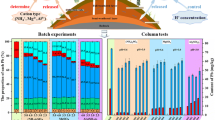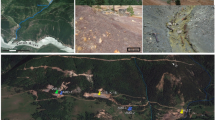Abstract
Thallium (Tl) is a highly toxic trace metal posing a significant threat to human health. Tl pollution in soils and chronic Tl poisoning related to Tl-rich sulfides weathering in the Lanmuchang mine of southwest Guizhou province, China, have been intensively studied in recent years. And yet, there are few studies on the role of secondary sulfate minerals associated with Tl mobility in this area. The sulfate minerals were characterized by XRD and SEM-EDS. The concentrations of Tl and other elements were determined by ICP-MS. The results show that sulfate minerals are predominantly melanterite, halotrichite, and fibroferrite. The average contents of Tl in rock, sulfate minerals, and soil samples were 156.4, 0.11, and 72.1 µg g−1, respectively. This study suggests that Tl in the mineralized rocks entered soils by pyrite oxidation with less scavenged of the sulfate minerals. The dissolution of the ferric sulfate minerals accelerates pyrite oxidation and maintains soil acidity, and this likely enhances Tl mobility from soil to crops.



Similar content being viewed by others
References
Aguilar-Carrillo J, Herrera L, Gutiérrez EJ, Reyes-Domínguez IA (2018) Solid-phase distribution and mobility of thallium in mining-metallurgical residues: environmental hazard implications. Environ Pollut 243:1833–1845
Aguilar-Carrillo J, Herrera-García L, Reyes-Domínguez IA, Gutiérrez EJ (2020) Thallium(I) sequestration by jarosite and birnessite: structural incorporation vs surface adsorption. Environ Pollut 257:1–11
Ballcžunlc T, Moelo Y, Loncar Ž, Micheelsen H (1994) Dorallcharite Tl0.8K0.2Fe3(SO4)2(OH)6, a new member of the jarosite-alunite family. Eur J Miner 6(2):255–264
Basallote MD, Cánovas CR, Olías M, Pérez-López R, Macías F, Carrero S, Ayora C, Nieto JM (2019) Mineralogically-induced metal partitioning during the evaporative precipitation of efflorescent sulfate salts from acid mine drainage. Chem Geol 530:1–11
Belzile N, Chen YW (2017) Thallium in the environment: a critical review focused on natural waters, soils, sediments and airborne particles. Appl Geochem 84:218–243
Bigham JM, Nordstrom DK (2001) Iron and aluminum hydroxysulfates from acid sulfate waters. Rev Miner Geochem 40(1):351–403
Buckby T, Black S, Coleman ML, Hodson ME (2003) Fe-sulphate-rich evaporative mineral precipitates from the RíoTinto, southwest Spain. Miner Mag 67(2):263–278
Casiot C, Egal M, Bruneel O, Verma N, Parmentier M, Elbaz-Poulichet F (2011) Predominance of Aqueous Tl(I) Species in the River System Downstream from the Abandoned Carnoulès Mine (Southern France). Environ Sci Technol 45:2056–2064
Chen DY (1989) The discovery of lorandite in China and its study. Acta Miner Sin 9(2):141–147 (in Chinese with English abstract)
Chen DY, Ren DY, Wang H, Zou ZX, Qin Y (1998) Where is the second thallium ore deposit of Lanmuchang type?—The discovery of Yangjiawan thallium deposit prospect and its prospecting potentiality. J Guizhou Univ Tech 27(5):18–26 (in Chinese with English abstract)
Chen DY, Wang GX, Zou ZX, Chen YM (2003) Lanmuchangite, a new thallium (Hydrous) sulphate from Lanmuchang, Guizhou Province, China. Chin J Geochem 22(2):185–192
Coup KM, Swedlund PJ (2015) Demystifying the interfacial aquatic geochemistry of thallium(I): new and old data reveal just a regular cation. Chem Geol 398:97–103
Dutrizac JE (1997) The behavior of thallium during jarosite precipitation. Metall Mater Trans B 28B:765–775
Elwood Madden ME, Madden AS, Rimstidt JD, Zahrai S, Kendall MR, Miller MA (2012) Jarosite dissolution rates and nanoscale mineralogy. Geochim Cosmochim Acta 91:306–321
Frau F (2000) The formation-dissolution-precipitation cycle of melanterite at the abandoned pyrite mine of Genna Luas in Sardinia, Italy: environmental implications. Miner Mag 64(6):995–1006
George LL, Biagioni C, Lepore GO, Lacalamita M, Agrosì G, Capitani GC, Bonaccorsi E, d’Acapito F (2019) The speciation of thallium in (Tl, Sb, As)-rich pyrite. Ore Geol Rev 107:364–380
Gomez-Gonzalez MA, Garcia-Guinea J, Laborda F, Garrido F (2015) Thallium occurrence and partitioning in soils and sediments affected by mining activities in Madrid province (Spain): soil–plant transfer and influencing factors. Sci Total Environ 536:268–278
Hammarstrom JM, Seal II, Meier RR, Jackson ALJC (2003) Weathering of sulfidic shale and copper mine waste: secondary minerals and metal cycling in Great Smoky Mountains National Park, Tennessee, and North Carolina, USA. Environ Geol 45:35–350
Hammarstrom JM, Seal IIRR, Meier AL, Kornfeld JM (2005) Secondary sulfate minerals associated with acid drainage in the eastern US: recycling of metals and acidity in surficial environments. Chem Geol 215:407–431
Jambor JL, Nordstrom DK, Alpers CN (2000) Metal-sulfate salts from sulfide mineral oxidation. Rev Miner Geochem 40(1):303–350
Jerz JK, Rimstidt JD (2003) Efflorescent iron sulfate minerals: paragenesis, relative stability, and environmental impact. Am Miner 88:1919–1932
Jia YL, Xiao TF, Zhou GZ, Ning ZP (2013) Thallium at the interface of soil and green cabbage (Brassica oleracea L. var. capitata L.): soil–plant transfer and influencing factors. Sci Total Environ 450–451:140–147
Jia YL, Xiao TF, Sun JL, Yang F, Baveye P (2018) Microcolumn-based speciation analysis of thallium in soil and green cabbage. Sci Total Environ 630:146–153
Joeckel RM, Ang Clement BJ, VanFleet Bates LR (2005) Sulfate-mineral crusts from pyrite weathering and acid rock drainage in the Dakota Formation and Graneros Shale, Jefferson County, Nebraska. Chem Geol 215:433–452
Kaplan D, Mattigod S (1998) Aqueous geochemistry of thallium. Wiley, New York, pp 15–29
Li GZ (1996) A study of compositions and thallium occurrence in mercury-thallium deposits at Lanmuchang of Xinren County in Southwestern Guizhou. Guizhou Geol 13(1):24–37 (in Chinese with English abstract)
Lin JF, Yin ML, Wang J, Liu J, Tsang DCW, Wang YX, Lin M, Li HC, Zhou YY, Song G, Chen YH (2020) Geochemical fractionation of thallium in contaminated soils near a large-scale Hg-Tl mineralised area. Chemosphere 239:1–8
Majzlan J (2010) Advances and gaps in the knowledge of thermodynamics and crystallography of acid mine drainage sulfate minerals. Chimia 64(10):699–704
Martin LA, Wissocq A, Benedetti MF, Latrille C (2018) Thallium (Tl) sorption onto illite and smectite: implications for Tl mobility in the environment. Geochim Cosmochim Acta 230:1–16
Nordstrom DK (1982) Aqueous pyrite oxidation and the consequent formation of secondary minerals. Wiley, New York, pp 37–56
Nordstrom DK, Alpers CN (1999) Negative pH efflorescent mineralogy and consequences for environmental restoration at the Iron Mountain Superfund site California. Proc Natl Acad Sci USA 96(7):3455–3462
Perotti M, Petrini R, D’Orazio M, Ghezzi L, Giannecchini R, Vezzoni S (2017) Thallium and Other Potentially Toxic Elements in the Baccatoio Stream Catchment (Northern Tuscany, Italy) Receiving Drainages from Abandoned Mines. Mine Water Environ 37:431–441
Romero A, González I, Galán E (2006) The role of efflorescent sulfates in the storage of trace elements in stream waters polluted by acid mine-drainage: the case of Peña Del Hierro, Southwestern Spain. Can Miner 44:1431–1446
Singer PC, Stumm W (1970) Acidic mine drainage: the rate-determining step. Science 167(3921):1121–1123
Vink BW (1993) The behaviour of thallium in the (sub) surface environment in terms of Eh and pH. Chem Geol 109:119–123
Voegelin A, Pfenninger N, Petrikis J, Majzlan J, Plötze M, Senn AC, Mangold S, Steininger R, Göttlicher J (2015) Thallium Speciation and Extractability in a Thallium- and Arsenic-Rich Soil Developed from Mineralized Carbonate Rock. Environ Sci Technol 52:5390–5398
Wick S, Baeyens B, Fernandes MM, Voegelin A (2018) Thallium Adsorption onto Illite. Environ Sci Technol 52:571–580
Wu P, Liu CQ, Yang YG, Zhang GP (2001) Release and transport of (heavy) metals and their environmental effect in mining activities. Acta Miner Sin 21(2):214–218 (in Chinese with English abstract)
Xiao TF (2001) Environmental impact of thallium related to the mercury-thallium-gold mineralization in Southeast Guizhou Province, China. Dissertation, University of Quebec
Xiao TF, He LB, Chen JA (2004) Aqueous environmental geochemistry of thallium in a thallium contaminated area of Southwest Guizhou. Earth Environ 32(1):35–41 (in Chinese with English abstract)
Xiao TF, Guha J, Boyle D (2004b) High thallium content in rocks associated with Au–As–Hg–Tl and coal mineralization and its adverse environmental potential in SW Guizhou, China. Geochem Explor Environ Anal 4:243–252
Xiong Y (2009) The aqueous geochemistry of thallium: speciation and solubility of thallium in low temperature systems. Environ Chem 6:441–451
Zhang BG, Zhang Z, Zhang XM, Chen GL (1997) A research into environmental geochemistry of Lanmuchang thallium deposit in Xinren of Guizhou Province. Guizhou Geol 14(1):71–77 (in Chinese with English abstract)
Zhang BG, Zhang Z, Hu J, Tian YF (2004) Thallium geochemistry and its ultra-normal enrichment. Guizhou Geol 21(4):240–244 (in Chinese with English abstract)
Zhou DX, Li SS (1981) Preliminary investigation on control and preventation of soil pollution by thallium. Acta Pedol Sin 19(4):409–411 (in Chinese with English abstract)
Acknowledgements
This work was funded by the National Key R&D Program of China (No. 2018YFC1802601) and the Science and Technology Planning Project of Guizhou province [(2018)1177].
Author information
Authors and Affiliations
Corresponding author
Additional information
Publisher’s Note
Springer Nature remains neutral with regard to jurisdictional claims in published maps and institutional affiliations.
Rights and permissions
About this article
Cite this article
Zhao, F., Gu, S., Hao, L. et al. Secondary Sulfate Minerals from Pyrite Oxidation in Lanmuchang Hg-Tl Deposit, Southwest Guizhou Province, China: Geochemistry and Environmental Significance. Bull Environ Contam Toxicol 107, 1004–1011 (2021). https://doi.org/10.1007/s00128-021-03358-6
Received:
Accepted:
Published:
Issue Date:
DOI: https://doi.org/10.1007/s00128-021-03358-6




